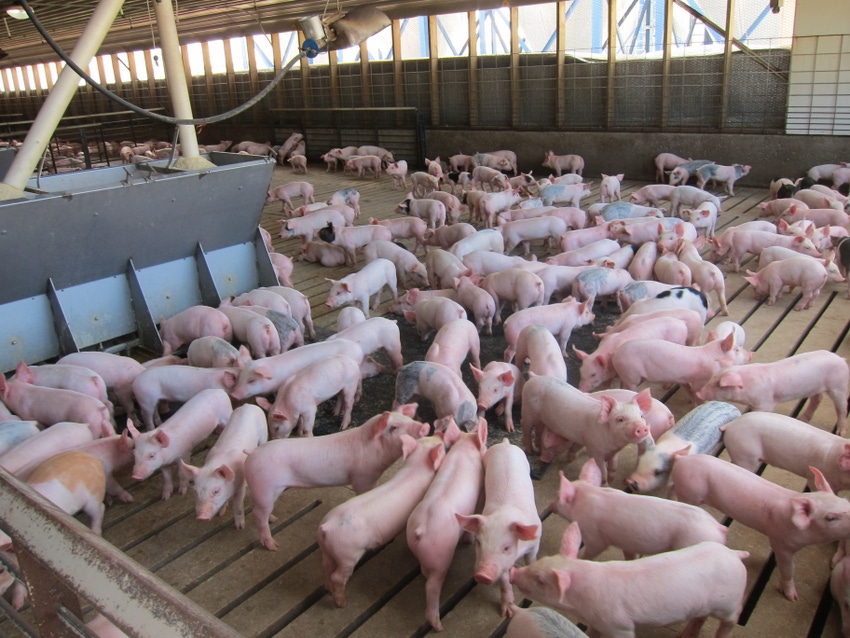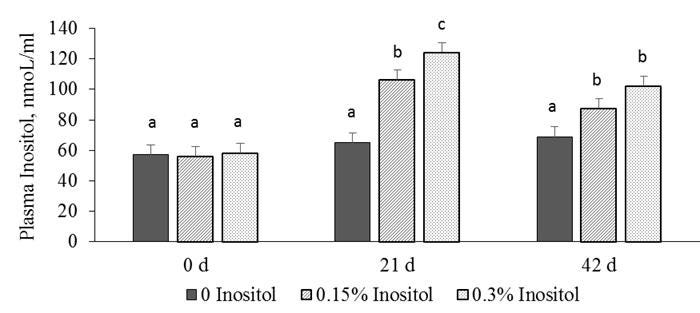Research shows the effect of inositol had a more significant metabolic impact in piglets during the most stressful time immediately after weaning.
November 9, 2017

By Eric van Heugten and Kory Moran, North Carolina State University; Pete Wilcock, AB Vista; and R. Dean Boyd, Hanor Co.
Recent studies have shown that super-dosing phytase improves growth performance of pigs compared to the standard phytase doses aimed at increasing availability of P1. High levels of phytase can cause almost complete degradation of the anti-nutritional factor phytate (inositol hexaphosphoric acid or IP6) and generate lower inositol phosphates (IP5-1) and inositol2. Previous work in poultry3 suggested that part of the benefit of super-dosing phytase could be attributed to the generation of inositol from the destruction of phytate4. Inositol is a cyclic sugar alcohol that exists predominantly as myo-inositol or phosphatidylinositol in tissue and cells of mammals5 and is a potent cellular mediator and regulates metabolism and growth6. Myo-inositol could play a role in improving growth performance in pigs, but its mode of action is still unclear and needs further investigation. To date, there are no published studies that have evaluated the supplementation of exogenous inositol and super-dosing phytase to determine physiological responses in pigs. Therefore, a study was designed to evaluate and compare the impact of supplementation of inositol and exogenous phytase at super-dosing levels on performance of nursery pigs housed under commercial conditions.
A total of 2,156 barrows and gilts (Camborough sow × PIC TR-4 sire) with an average initial BW of 6.75 ± 0.11 kilograms were used in a 42-day study. Pigs were placed in a total of 98 pens (22 pigs per pen), blocked by weight and sex and randomly assigned to one of six dietary treatments (16 to 17 replicates per treatment). Two phytase doses (0 and 2,500 FTU per kilogram) and three inositol inclusion levels (0, 0.15 and 0.30%) were combined to create the six dietary treatments in a 2 × 3 factorial arrangement. Pigs were fed a three-phase feeding program, with each period being 10, 10 and 22 days, respectively. Pig weights and feed disappearance were measured by pen for each phase to calculate ADG, ADFI and F:G. Fecal consistency was determined, and fecal scoring was initiated on Day 1 post placement for 10 days. The fecal scoring system consisted of the following: 0 = normal feces; 1 = soft feces; 2 = fluid feces; and 3 = completely liquid, projectile feces (wet hindquarters). A subset of 48 pigs from 48 pens eight pigs per treatment) was selected to collect blood samples to determine plasma inositol concentrations.
Data were analyzed using SAS (SAS Inst. Inc., Cary, N.C.) as a randomized complete block design with a 2 × 3 factorial arrangement of treatments. Growth performance data were analyzed using the GLM procedure using the pen as the experimental unit with inositol level, phytase concentrations, block and the interaction of inositol level and phytase concentration as fixed effects in the model. Concentrations of inositol and fecal score data were analyzed by the MIXED procedure as repeated measures over time on each experimental unit.
Results showed an interactive effect (P = 0.015) between phytase and inositol for feed efficiency during Phase 1 (the first 10 days after weaning), showing that increasing levels of inositol improved the feed:gain ratio in pigs fed diets without supplemental phytase in a linear manner, but did not impact feed efficiency in pigs with super-dose levels of phytase (Figure 1). The improvement in feed efficiency with supplemental inositol was similar in magnitude as the improvement observed with super-dosing of phytase. No effects of inositol supplementation on growth performance were observed during subsequent periods or overall. Super-dosing of phytase improved feed efficiency (P < 0.001) during the first phase after weaning and improved (P < 0.001) average daily gain during the second phase (Day 11 to 20 after weaning).
Figure 1: Impact of phytase and inositol on feed:gain in nursery pigs during the first 10 days after weaning

Plasma inositol increased linearly (P < 0.001) with increasing supplemental inositol when measured 21 and 42 days after weaning (Figure 2). Super-dosing of phytase to the diet without supplemental inositol did not affect plasma inositol concentrations compared to control diets when measured on Day 21 (59.2 versus 70.7 mmol per milliliter for control versus 2,500 FTU per kilogram phytase), but it tended to increase plasma inositol when measured on Day 42 (56.5 versus 81.4 mmol per milliliter for control versus 2,500 FTU per kilogram phytase). This suggests that super-dosing phytase can release inositol, but not to the extent that can be accomplished with the direct supplementation of inositol. The limitation of inositol release with phytase compared to supplemental inositol in this experiment may be attributed in part to the limited substrate (phytate) present in the diet needed to liberate an equivalent level of inositol, especially in relation to the high inositol supplemented the diet.
Figure 2: Impact of inositol supplementation on plasma inositol concentrations measured at weaning (Day 0) and 21 and 42 days after weaning.

Results suggest that the improvement in performance when applying super-dosing levels of phytase could be partially linked to phytate degradation and inositol production and that positive effects of inositol were limited to the first 10 days after weaning. It should be noted that pigs in this study were extremely healthy, as suggested by lack of diarrhea (measured diarrhea scores were less than 1 and were not impacted by diet), low death losses (0.26% in the first 42 days post weaning), high average daily gain (1.16 pounds per day) and body weight (63 pounds after 42 days on feed), and excellent feed efficiency (feed:gain of less than 1 during the first 10 days after weaning and 1.39 overall). This may have limited potential longer-term benefits of inositol supplementation or super-dosing of phytase. Results suggest that the improvement in performance when applying super-dosing levels of phytase may be partially linked to inositol production and that the effect of inositol (supplemented or liberated by phytase) had a greater metabolic impact in piglets immediately after weaning. This suggests that inositol may be conditionally essential during the first days of the post-weaning period, which is well known as the most stressful period during the life of pigs.
1Wilcock et al., 2014; Koehler et al.; 2015; Lee and Bedford, 2016
2Cowieson et al., 2011; Holloway et al., 2016
3Karadas et al., 2010; Cowieson et al., 2013; Walk et al., 2014; Cowieson et al., 2015
4Adeola and Cowieson, 2011; Wilcock et al, 2014
5Holub, 1986
6Hawthorne and White, 1976
You May Also Like



